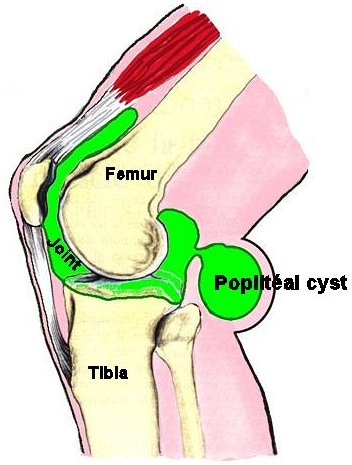These cysts are not dangerous and are in no way related to
cancerous tumors. A popliteal cyst is simply a sac filled with normal joint
fluid. A cyst will vary in size within a given patient, depending on the quantity
of fluid present in the knee. When the cyst is small, it is asymptomatic.
However, when large it can cause pressure and be a source of pain. On rare
occasions, the cyst can be large enough to exert pressure on the nerves or
vessels in the back of the knee, in which case the patient may feel a burning
sensation down the leg, or pins and needles. He or she may also note swelling
of the leg. In certain cases, the cyst can also burst. This is associated
with the sudden onset of pain and swelling in the calf. The condition can
mimic phlebitis or a torn calf muscle.
Feeling a little bump behind the knee should immediately
bring this diagnosis to mind. The bump can change in size from day to day.
It is usually most obvious when the knee is straight. It can disappear outright
when the knee is bent. A sonogram can confirm the diagnosis as well as identify
its exact location and define its volume. This kind of cyst is usually the
result of some problem within the knee joint itself. Therefore, the presence
of popliteal cyst should alert the doctor to the possible presence of a torn
cartilage, arthritis or other "intra-articular" pathology.
Popliteal cysts will not uncommonly resolve on their own,
as the fluid gets absorbed by the body or flows back into the knee joint.
Since it is a completely benign condition, no other treatment is required.
On occasion the cyst is large enough that it warrants aspiration
and even injection of a steroid solution, which helps ""dry it up."
Because the cyst is related to problems within the knee joint, the persistence
of a cyst may require a surgical procedure within the knee joint itself. Direct
removal of the cyst is rarely warranted since the cyst tends to recur.

